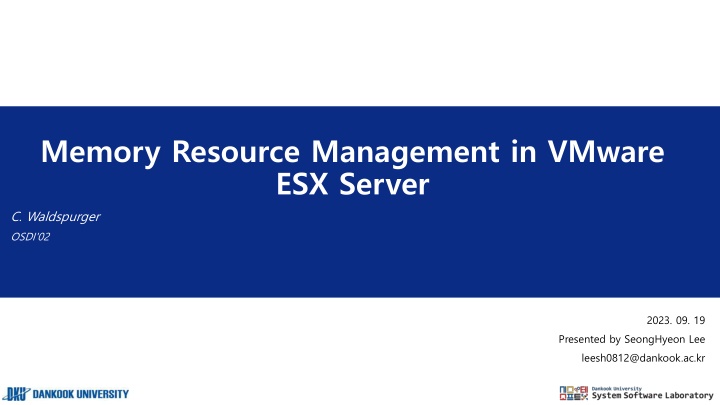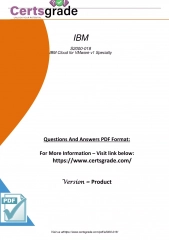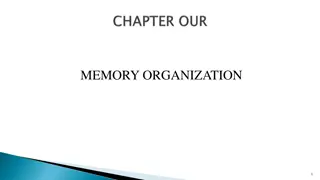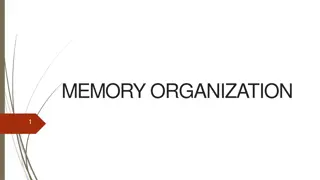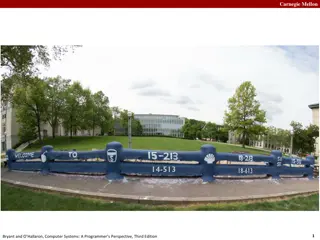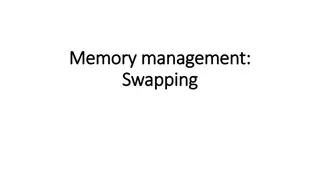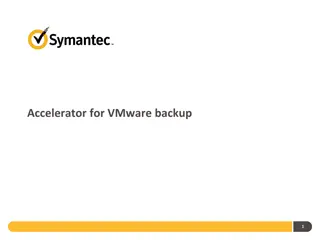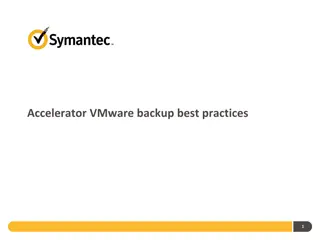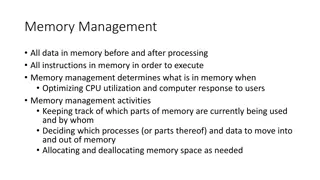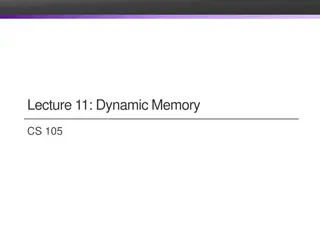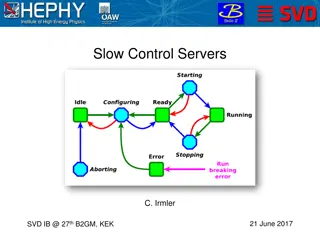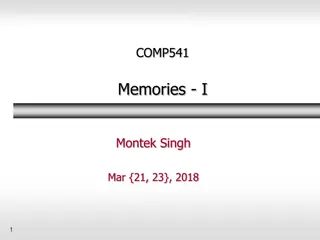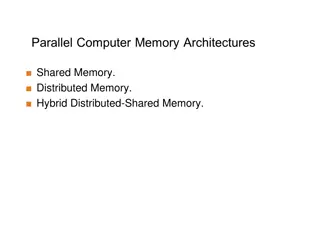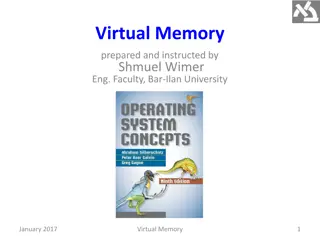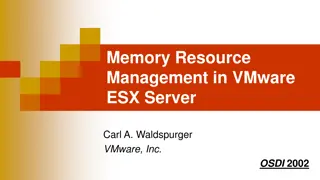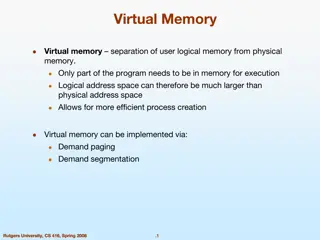Memory Resource Management in VMware ESX Server
Discusses memory resource management strategies in VMware ESX Server, including reclamation mechanisms, memory overcommitment, and virtualization techniques. Covers topics such as balloon control, page remapping, and real hardware memory virtualization.
Download Presentation

Please find below an Image/Link to download the presentation.
The content on the website is provided AS IS for your information and personal use only. It may not be sold, licensed, or shared on other websites without obtaining consent from the author.If you encounter any issues during the download, it is possible that the publisher has removed the file from their server.
You are allowed to download the files provided on this website for personal or commercial use, subject to the condition that they are used lawfully. All files are the property of their respective owners.
The content on the website is provided AS IS for your information and personal use only. It may not be sold, licensed, or shared on other websites without obtaining consent from the author.
E N D
Presentation Transcript
Memory Resource Management in VMware ESX Server C. Waldspurger OSDI'02 2023. 09. 19 Presented by SeongHyeon Lee leesh0812@dankook.ac.kr
Outline Outline - ESX Server - Reclamation Mechanisms - Sharing Memory - Reallocation and Remapping - Conclusion 2
ESX Server ESX Server (Understanding Memory Resource Management in VMware ESX 4.1, ESX Vmware) 3
ESX Server ESX Server ( , https://suyeon96.tistory.com/52 suyeon96) 4
ESX Server PPN : Physical Page Number -> VM Memory MPN : Machine Page Number -> Real Hardware Memory Virtualization (Understanding Memory Resource Management in VMware ESX 4.1, ESX Vmware) 5
ESX Server Memory Virtualization Hypervisor Guest OS 6
ESX Server Memory overcommitment in ESX (Understanding Memory Resource Management in VMware ESX 4.1, ESX Vmware) But, it necessitates replacement policies and resource management decisions 7
Reclamation Mechanisms Ballooning - Dynamically adjusting and reclaiming less critical memory 1. Using balloon control to inflate memory within the guest OS (allocating memory from less important or free list). 2. Transmitting physical memory page information: The balloon driver transmits the physical page numbers (PPNs) of the allocated pages to the hypervisor. 3. Balloon deflation: As needed, the hypervisor instructs the balloon driver to release memory. ( Memory Ballon Driver , https://docs.vmware.com/en/VMware- vSphere/7.0/com.vmware.vsphere.resmgmt.doc/GUID-5B45CEFA-6CC6-49F4-A3C7- 776AAA22C2A2.html, by Vmware Docs) 8
Reclamation Mechanisms Ballooning 9
Reclamation Mechanisms Ballooning - The balloon driver may be removed, deactivated, unavailable during guest OS boot, or unable to reclaim memory quickly enough. - Various guest OS limitations may set an upper bound on a reasonable balloon size. In cases where the balloon mechanism is unavailable or insufficient, the system falls back on paging mechanisms.
Sharing Memory TPS(Transparent page Sharing) - Mapping identical pages within a VM's memory to the same physical page - dlls, exes, etc. that always run when using an app on the same OS - Incurs a cost to find identical pages ( Bye bye Transparent Page Sharing , https://vinfrastructure.it/2014/10/bye-bye-transparent- page-sharing/, by Andrea Mauro) - Finding by comparing every single page is highly inefficient and costly
Sharing Memory Content-based page sharing - Identifying duplicate pages by content - Pages with the same content can be shared, irrespective of when, where, or how they were created. (Understanding Memory Resource Management in VMware ESX 4.1, ESX Vmware)
Sharing Memory Content-based page sharing
Sharing Memory Implementation - The total space overhead of the page sharing system is less than 0.5% of system memory - The level of sharing approaches 67% as the number of VMs increases, indicating that about two-thirds of all memory overlaps between VMs. - The CPU overhead due to page sharing was negligibly small.
Sharing Memory Content-based page sharing Real-World Page Sharing Page Sharing Performance
Sharing Memory Shares vs. Working Set - Traditional operating systems improve performance by adjusting memory allocations - But, this conflicts with ensuring service quality proportionate to what's paid 16
Sharing Memory Reclaiming Idle Memory - Charging a client more for an idle page than for one it is actively using - The tax rate specifies the maximum fraction of idle pages that may be reclaimed from a client - If the client later starts using a larger portion of its allocated memory, its allocation will increase, up to its full share ?: adjusted shares-per-page ratio S: total shares allocated to a client P: total pages allocated to a client f: fraction of active pages k: coefficient reflecting the tax rate for idle memory 17
Sharing Memory Reclaiming Idle Memory ? ? f ? f reclaim f reclaim ? 0 , reclaim ? ? 1 , reclaim ? ? 18
Sharing Memory Measuring Idle Memory - Statistical sampling (ESX Server samples 100 pages every 30-second period) - A small number of the virtual machine s physical pages are selected randomly using a uniform distribution - Invalidating any cached mappings associated with its PPN - The system detects that access and restores the mappings, then it is in an active state 19
Sharing Memory Slow : Fast : Sharing Memory Idle Memory Tax Active Memory Sampling 20
Sharing Memory Reclaiming Idle Memory - When VM is allowed to power on Ensure (sufficient memory + swap space) Max - Min Min+Overhead VM Graphics Frame Buffer + Virtualization Data Structures Pmap Shadow, page tables 21
Reallocation and Remapping Dynamic Reallocation - ESX Server dynamically recomputes memory allocations in response to various events - ESX Server utilizes four thresholds: high, soft, hard, and low, which(6%, 4%, 2%, 1%) - Calculates the target allocations to maintain the aggregate amount of available space above the high threshold I/O Page Remapping - Overcommitment may lead to problem that guest OS may address machine page that doesn't exist - Keep track of "hotness" of pages in high memory and when the I/O refernce count of such pages exceed certain threshold, they are remapped to low memory 22
Reallocation and Remapping Dynamic Reallocation Dynamic Reallocation 23
Conclusion Fundamental mechanisms and policies for memory management in ESX Serve - Ballooning Reclamation Mechanisms - Content-based page Sharing Sharing Memory - Idle memory tax Sharing Memory - Hot I/O page remapping Page Remapping Currently underway on EXSi 24
Q&A Q&A 25
